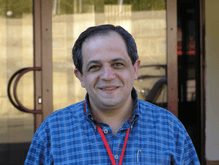Gagik Shmavonyan
Gagik Shmavonyan (Armenian: Գագիկ Շմավոնյան, May 12, 1963) is Professor at National Polytechnic University of Armenia,[1] PhD in Physics, D.Sc in Engineering.[2][3][4], President of "NanoHiTech" Association (Nanotechnology), International Expert in Nanotechnology and Chief Scientific Coordinator of multidisciplinary research group of scientific experts from different countries at LarrainVial Investment and Advisory Company (Santiago de Chile, Chile), as well as Advisor at Ministery of High-Tech Industry of Armenia and State Committee of Science of Armenia.
Gagik Shmavonyan | |
|---|---|
 | |
| Born | May 12, 1963 Yerevan, Armenia |
| Title | Professor at National Polytechnic University of Armenia International Expert in Nanotechnology at LarrainVial Investment & Advisory Company |
| Website | https://gagikshmavonyan.am/ |
Professor Shmavonyan has worked in 8 countries (Taiwan, UK, Italy, Germany, Ireland, Spain, Greece, France), taught in three universities within three countries (UK, France, Armenia) and visited more than 30 countries.
He has authored/co-authored more than 50 refereed papers, 120 Conference papers, 20 patents, 3 books, 1 problem book, 1 Monograph and a chapter in 3-volume textbook “Optical Nanospectroscopy” for European students. His two papers devoted to graphene are cited in Graphene Science Handbook: Applications and Applications and Industrialization, Ed. by M. Aliofkhazraei, etc., CRC Press, 2016 and 3-volume textbook “Optical Nanospectroscopy”, Ed. by Mc. Millan Norman, de Gruyter, 2020.
His current research interests are 2D atomic materials, their hybrid structures and devices.
G. Shmavonyan is co-author of:
• Unique technology: simple (one-step), fast (150 seconds), cheap, transfer-free, highly productive, ecologically clean and universal (any 2D material can be obtained) substrates rubbing technology for mass production of large size unique 2D atomic sheets (graphene, etc.), their hybrid structures and devices on any rigid and flexible inorganic and organic substrates.
• 1st Mechanical Ballpoint Pencil,
• The broadest semiconductor optical amplifier for optical communication band.
• Nanoeffects: a) Bi-directional guided effect of lasing mode in a bending waveguide of semiconductor optical amplifier, b) An optical switching effect in one semiconductor optical amplifier for optical communication band, c) The effect of separate confinement heterostructure layer thickness.
He is involved in coordination and advisory of different International R&D projects financed by NATO, UN Industrial Development Organization, Philip Morris International, Larranvial Company (Chile), Heritage Science Foundation (Paris, France), Cariplo Foundation (Italy), Abdus Salam International Centre for Theoretical Physics (Trieste, Italy), etc.
He is an International Expert in different Scientific Committees and Foundations, such as European Cooperation in Science and Technology (COST) Association (Brussels), i2mfund (USA), Cyprus Research Promotion Foundation, State Committee of Science of Armenia, as well as Editorial board member of International Journals, Organizing Committee member and Session Chair of International Conferences.
His most significant research awards are: ″Cleantech Oscar″ Award at UNIDO Cleantech Open Global Ideas Competition 2015 (San Francisco, USA), National Winner (2015) and Runner-up (2014) of CleanTech Armenia Competition; ARPA Institute Invention Competition Awards (2013 and 2014, Los Angeles, USA).
He is member of Management Committees of European Cooperation in Science and Technology (COST) Projects: CA15107 “Multi-Functional Nano-Carbon Composite Materials Network” (2018-2020), MP1302 “NanoSpectroscopy” (2015-2017) and MP0901 "Designing Novel Materials for Nanodevices - from Theory to Practice" (2011-2014), Athens Institute for Education and Research (Greece), International Association of Advanced Materials (Sweden) and St. Petersburg Scientific and Educational Society (Russia).
Education
He got his PhD in Physics in 1996 and D.Sc in Engineering in 2009 at National Polytechnic University of Armenia. He did postdoc at National Taiwan University (2001–2002). He was an Invited/Visiting Professor/Scholar at the University of Hull, UK (2000, 2003), Polytechnic of Milan, Como, Italy (2004–2005), University of Bremen, Germany (2002, 2006), Free University Berlin, Germany (2011), Trinity College Dublin, CRANN, Ireland (2012), University of Santiago de Compostela, Spain (2013–2014), Institute of Nanoscience and Nanotechnology, National Center for Scientific Research "Demokritos", Athens, Greece (2017), University of Cergy-Pontoise, France (2016, 2017), Eberhard Karls University of Tübingen, Germany (2019).
Research interests
- 2D atomic materials (graphene, etc.), smart materials, 2D hybrid atomic structures,
- 2D atomic devices, 2D flexible electronics,
- Nanostructured optoelectronic devices: photoelectrochemical, photovoltaic and thermophotovoltaic cells, perovskite solar cells, semiconductor lasers and semiconductor optical amplifiers, etc.
Selected publications
- Shmavonyan G.Sh. Monograph Chapter Graphene and two-dimensional atomic materials and their hybrid structures in the 3 Volume Textbook Optical Nanospectroscopy, Vol. 1: Fundamentals, Vol. 2: Methods, Vol. 3: Applications, McMillan N., Sheremet E., Fleischer M. (Eds.), Publisher De Gruyter, 2021 (in English) (in press).
- Shmavonyan G.Sh., Vázquez Vázquez C., López-Quintela M.A. Single-step rubbing method for mass production of large-size and defect-free two-dimensional material nanostripes, films and hybrid nanostructures on any substrate, Transl. Mater. Res., IOP Publishing, 4 (2), 025001, 2017.
- Shmavonyan G.Sh. Monograph Semiconductor nanostrucured optolectronic devices, “Engineer” press, Khachatryan N.A. (Eds.), Yerevan, Armenia, 250 p., 2017 (in Armenian), 2019.
- Petrosyan O.H., Shmavonyan G.Sh., Vardanyan A.A. Nanoelectronic elements and devices, Academic manual, “Engineer” press, Khachatryan N.A. (Eds.), Yerevan, Armenia, 326 p., 2019 (in Armenian).
- Shmavonyan G.Sh. Basics of Nanotechnologies, Academic manual, “Engineer” press, Khachatryan N.A. (Eds.), Yerevan, Armenia, 224 p., 2011 (in Armenian), ISBN 978-9939-55-605-5.
- Ispiryan N.P., Shmavonyan G.Sh. Physics of Semiconductors, Problem book, “Engineer” press, Khachatryan N.A. (Eds.), Yerevan, Armenia, 111 p., 2010 (in Armenian), ISBN 978-9939-55-438-9.
- Buniatyan V.V., Shmavonyan G.Sh., Martirosyan N.V. Investigation methods of electronic and opto¬elec¬tro¬nic solid state materials and structures, Academic manual, “Engineer” press, Khachatryan N.A. (Eds.), Yerevan, Armenia, 418 p., 2005 (in Armenian).
References
- "Учёный из Армении создал и запатентовал способ получения "материала будущего"". golosarmenii.am. Retrieved 2017-12-18.
- "Armenia scientist patents cost effective and ecologic method of getting 'material of future'". news.am. Retrieved 2017-12-18.
- Mediamax. "Cleantech. Բիզնես՝ մաքուր տեխնոլոգիաների օգնությամբ". iTel.am. Retrieved 2017-12-18.
- "ՊԱՐԳԵՎԱՏՐՈՒՄ՝ ՀԱՊՀ-Ի ՌԵԿՏՈՐԱՏԻ ՆԻՍՏՈՒՄ - Հայաստանի Ազգային Պոլիտեխնիկական Համալսարան". Հայաստանի Ազգային Պոլիտեխնիկական Համալսարան. 2015-12-08. Retrieved 2017-12-18.